SynCoral as a proxy for natural coral reef substrates

Gerald Goeden & Anne-Mette Jørgensen
In the face of declining fish populations, artificial reefs are seen as a possible way to increase stocks and food security. SynCoral is being developed as an environmentally friendlier alternative to concrete, which is commonly used in the construction of artificial reefs. In this research, we compare three different, commonly deployed artificial reef designs with Prototype SynCoral structures on Hook Reef, Great Barrier Reef. We also compare these artificial reefs with 100 Natural reef sites on Wistari Reef, Great Barrier Reef.
We found that SynCoral artificial reefs supported significantly greater fish abundance than the other tested artificial reefs when overall reef size was kept the same. SynCoral also supported larger numbers of juvenile fish, suggesting that increased levels of production are possible. We compared Natural Reef habitats with SynCoral using Hedges’ g and found that where the mean fish biomass/50m2 for SynCoral was 15.04 kg/50m2, the most similar natural habitat types on Wistari Reef were Sand/Rubble with 19.73 kg/50m2 (g: 0.586950) and Compact Flat with 18.64 kg/50m2 (g: 0.597085). We were able to show that abundance and biomass were correlated with rugosity and suggest that designing SynCoral artificial reefs can play a significant role in building new or replacing lost coral reef fish communities.
You can read the full paper below or download it as a pdf SynCoral as a Proxy
Introduction
Coastal reefs have faced anthropogenic threats for many decades. These include habitat destruction, pollution, climate change, and overharvesting (Millennium Ecosystem Assessment, 2005; Lotze et al., 2006). Perhaps the most effected reef formations are coral reefs. They provide a variety of necessary economic goods and services to humanity valued at nearly US$400 billion or about US$6,000 per hectare per annum (Edwards and Gomez, 2007). It now seems likely that coral reef loss is so rapid and widespread as to globally threaten the existence of the habitat and its various populations (Burke et al., 2011; McClenachan et al., 2017). The consequent, dramatic loss of ecosystem services has prompted nature conservers to attempt to offset the problem by enhancing or expanding existing reefs. In most cases, the enhancement of reef habitats has been attempted through the addition of artificial structures, i.e. artificial reefs (Seaman, 2007; Becker et al., 2018).
An artificial reef is formally defined as a “submerged structure deliberately constructed or placed on the seabed to emulate some functions of a natural reef, such as protecting, regenerating, concentrating, and/or enhancing populations of living marine resources” (United Nations Environment Programme, 2009). Over the years, a wide variety of materials have been used in constructing artificial reefs, including concrete blocks, formed concrete modules, polyvinyl chloride (PVC) pipe, used tires, and other materials of opportunity (e.g. derelict ships, car bodies, and building rubble) (Paxton et al., 2020). In some cases, existing structures such as decommissioned oil and gas jackets are toppled or relocated to create fish shelters (Macreadie et al., 2011). Attempts to construct artificial reefs using electrochemical accretion (biorock) have met with limited success. Results for electrochemically accreted “reefs” at Tioman Island, Malaysia were summarized by Affendi (2014). Most recently, artificial reefs have been 3D-printed, using mixtures of cement and other materials (Albalawi et al., 2021).
The earliest recorded artificial reef was in Japan in the 1600s (Stone et al., 1991) but the greatest increase in the use of artificial reefs began in the 1950s when fishermen deployed disposable material to increase opportunity and catch. In many countries today, artificial reef construction is organized through government-directed artificial reef programs (McGurrin et al., 1989; National Oceanic Atmospheric Administration, 2007). The rapid growth in artificial reef deployment in the face of dwindling fisheries and coral communities is now globally widespread across temperate and tropical systems and no longer limited to the more developed countries (Seaman, 2002; Ilieva et al., 2019). Common goals revolve around fisheries management and yield, mitigation of habitat loss, and restoration of structural and substrate loss (Becker et al., 2018).
Although artificial reefs have been the subject of extensive research over the last 50 years, there is ongoing debate as to whether artificial reefs are comparable in ecological function to natural reefs (Carr and Hixon, 1997; Simon et al., 2013; Granneman and Steele, 2015), increase abundance (Paxton et al., 2019), provide nursery areas (Mercader et al., 2017), or act as producers or attractors of fish (Bohnsack et al., 1997). Some artificial reefs have been shown to support equivalent amounts and functional groups of fish as their natural counterparts (Stone et al., 1979; Lemoine et al., 2019). But this is not always the case and artificial reefs have been documented with both more (Bohnsack et al., 1994; Arena et al., 2007; Paxton et al., 2017) and less (Carr and Hixon, 1997; Froehlich and Kline, 2015) individuals and fish species. Evidence for whether artificial reefs support similar fish communities to natural reefs remains mixed (Paxton et al., 2020).
SynCoral is a man-made material suitable for artificial reef construction. Our prototype material was concrete based, had a low carbon footprint and incorporated inexpensive recycled or waste materials. These Prototype SynCoral modules were designed so that they could be assembled underwater by two divers. But, SynCoral can be cast in a variety of shapes and sizes and features like rugosity can be “designed in”.
The purpose of this document is to compare Prototype SynCoral artificial reef modules with other artificial reef modules and with 10 different Habitat Types at 10 different locations on a natural reef. Data from all the artificial reef modules are used to create regressions and compare artificial and natural structures.
Methods
In the first part of this study, we sampled fish assemblages on four types of artificial reef “modules” from 06/2004 through 06/2005 at quarterly intervals at Hook Reef, Great Barrier Reef (Goeden G.B. and Ismail M.S., in press A). We deployed Reef Balls, Building Rubble, Layer Cakes and a Prototype SynCoral© (see figure 1).
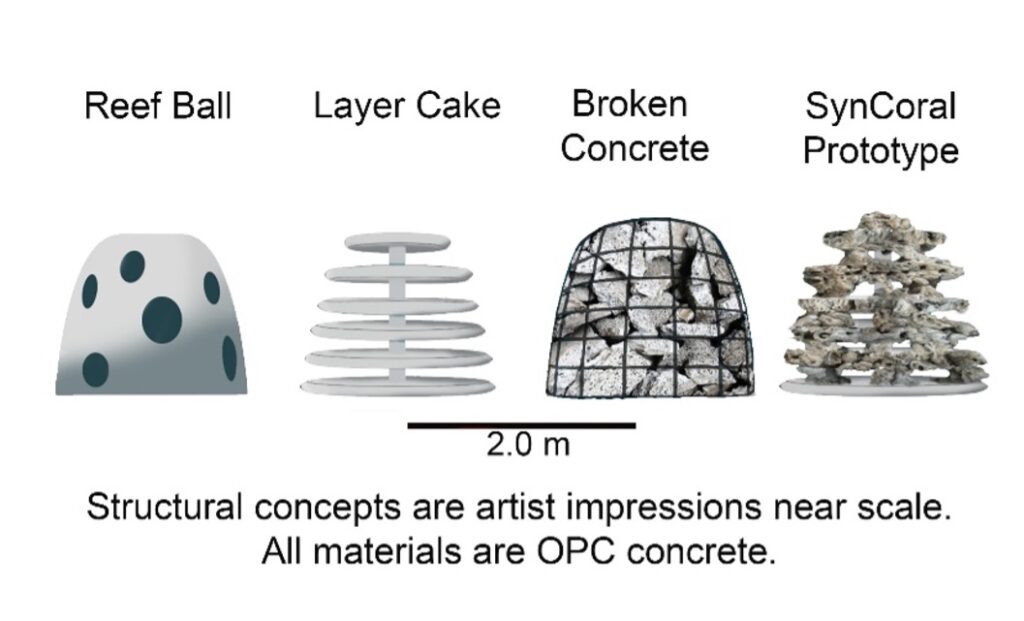
All artificial reef modules were manufactured onshore using Ordinary Portland Cement (OPC) concrete and concrete waste for their structure. To achieve some degree of standardization, all modules were patterned after the common Reef Ball as semi-ellipsoids and had very similar external dimensions and shape. To maintain form, Broken Concrete waste was retained in a shaped steel reinforcing mesh (0.2mx0.2m mesh openings) with a near circular opening at the top for hand loading the rock. The Control areas were “mostly open”, hard-sand bottom with numerous, scattered small coral rubble. We used a number of steel pins connected by a wire placed at a distance of 6.0m from the artificial reef modules and in the Control areas to mark a further “radius of influence” for each site. The “radius of influence” figure is supported by Madin, et al. (2011) who looked at grazing around patch reefs on Heron Island, Great Barrier Reef. They found that the impact of reef grazers was minimal at distances greater than 6-9m.Artificial reef modules were deployed in two separate groups containing sets of four (laid out in separate clusters) for each structure type. Each type formed a square with module separation of about 8m (center to center) or 6m (edge to edge) so that each set of four occupied an area equal to its own footprint plus a functional “radius of influence” of another 6.0m, or about 480m2 in total. See Figure 2. We counted fish within about 2m of the bottom resulting in a sampled volume of about 1,000m3. Each set of four was located at least 50m from other sets and at least 150m from live coral patch reef outcrops. Numbers of each species were counted, but are pooled here into “functional groups” paralleling the functional groups of Williams and Polunin (2001) and allowing comparison with the Wistari Reef data (discussed below).
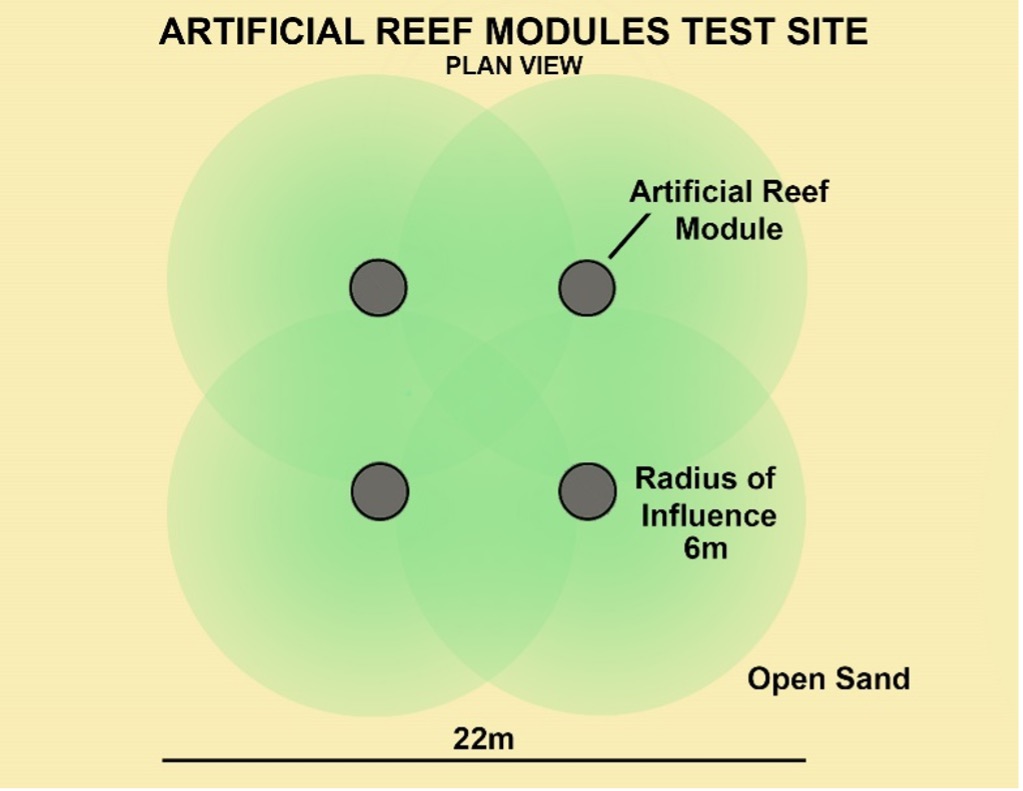
For the second part of the study, we sampled the fish populations of natural reefs at Wistari Reef, Great Barrier Reef in January, 2006. We used data from 10 cells (belt transects) within each of 10 habitat types (100 cell total) from around the perimeter of the reef. Each rectangular cell counted measured 5m x 10m with the long axis parallel to the reef crest. Note that our comparisons here are between “functional groups” of several taxa rather than single species. Bradbury and Goeden (1974) counted an estimated 205 species in the same cells and then compressed these to genera and families for analysis (1) to overcome possible identification problems especially in “mixed schools” and (2) to determine the partitioning of the reef at a more functional level; i.e., collections of taxa deemed to be functionally similar and paralleling the groups of Williams and Polunin (2001).
We compared artificial and natural reef samples using Hedges’ g. This is a measure of effect size (Hedges, 1981). Effect size describes how much one group differs from another—in this case we treat increasing effect size as a measure of difference among SynCoral modules and natural reefs. We adopted Cohen’s (1977) criteria for “g values”: small difference = 0.2, medium difference = 0.5, and large difference = 0.8 where one unit of “g” can be thought of as one standard deviation, σ.
Many coral reef surveys have shown that the linear length of a transect compared to the length of the undulating path over the same substrate is a measure of reef rugosity and that this measure of habitat complexity closely relates to fish abundance (Goeden, 1971; Risk, 1972; Luckhurst & Luckhurst, 1978; Carpenter et al., 1981; Turnigan, 1991; McCormick, 1994; Friedlander, A.M. & Parrish, J.D. (1998); Gratwicke & Speight, 2005; Kuffner et al., 2007; Shumway et al., 2007; Wilson et al., 2007; Purkis et al., 2008; Walker et al., 2009).
For the artificial reefs, we used total surface area of a collection of artificial reef modules added to the surrounding substrate on a 480m2 site compared to the horizontal bottom area that the site occupied to describe our site “rugosity”. Our novel measure of “three dimensional rugosity” has a range from 0 (very flat) to almost 1 (very convoluted). For comparison with Wistari data, we used 1 – (square root substrate area/square root site area) to calculate a “linear” rugosity.
Fish biomass was calculated from fish counts using the length-weight (cm:g) equation W = a * TLb. The coefficients ‘a’ and ‘b’ were taken from a table by Kulbicki et al. (2005) and based on the median size of each size class. For each taxon, the number of fish belonging to each size class was summed and then converted to weight in kg and then summed by functional group. Finally, all taxa weights were summed for total biomass in kg per Reef Type.
Results
The abundance of individual fishes is perhaps the most common means of assessing production on reefs, both artificial and natural. Similarly, it’s a common way to compare artificial reef efficacy. Comparing the abundance of fish on the artificial reefs, we found SynCoral supported significantly larger numbers of individuals, p<.001, throughout the study (Fig. 3).
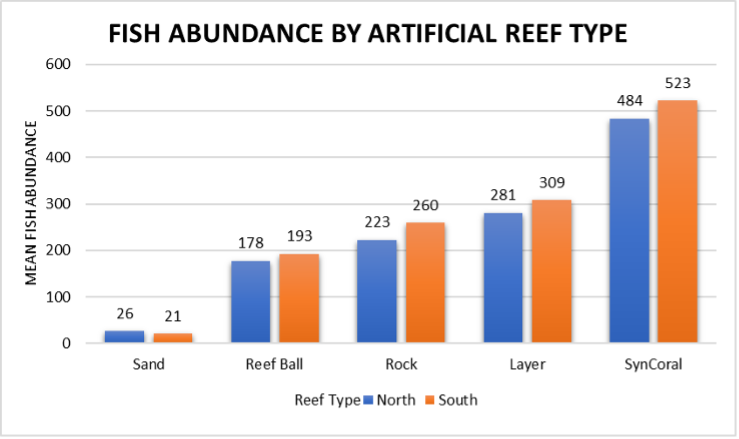
We compared the fish abundance on the 10 different habitat types on Wistari Reef with SynCoral using Hedges’ g and found that two natural reef habitats were moderately similar. All of the other artificial reef types had significantly different g values. Moderately similar areas were the deeper sand/rubble (g: 0.598672) at the bottom of the reef slope and the shallower compact flat (g: 0.544975) (see Figures 4). These areas bore a remarkably similar textural appearance to samples of SynCoral.
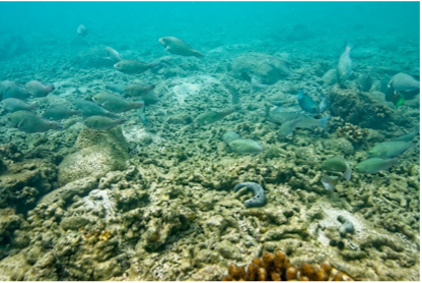
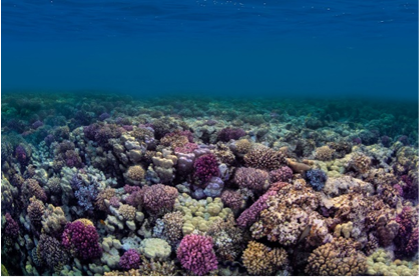
Comparing SynCoral fish density with Wistari natural habitat types, we find that the primary difference was in the variance (Figure 5). The mean fish density/50m2 for SynCoral was 52.22 compared to 68.1 for sand/rubble and 61.9 for compact flat. The next association was for low stag with a density of 65.0 fish/50m2 (g: 0.843429). The higher “g” for low stag is attributable to a greater standard deviation due to an outlier, therefore, this habitat type was treated as a “large difference”. Other natural habitat types had significantly different fish density distributions from SynCoral.
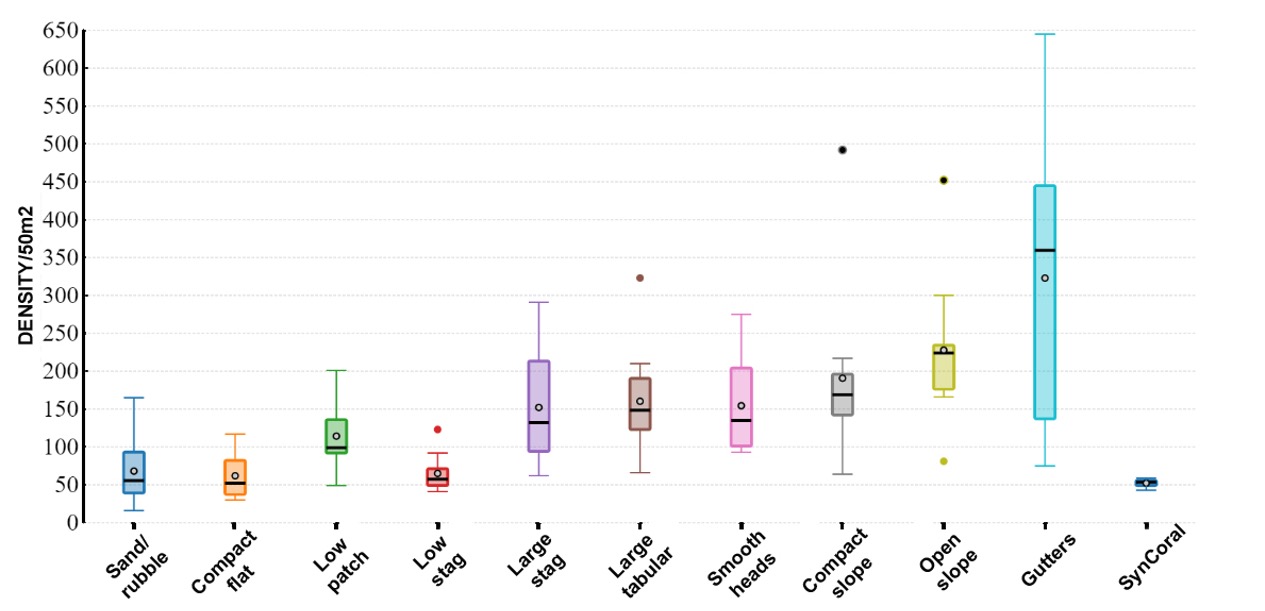
In Figure 6, all the samples are plotted as bars with North and South Hook Reef samples grouped together. Variance among the 20 natural habitat cells (10 sand/rubble and 10 compact flat) is quite high and probably the result of their different locations and depths around the reef. The SynCoral data is from only two sites (North and South Hook Reef) at five different sampling dates and is far less variable among samples. Variance aside, the average performance of SynCoral and these two natural reef habitats is clearly similar.
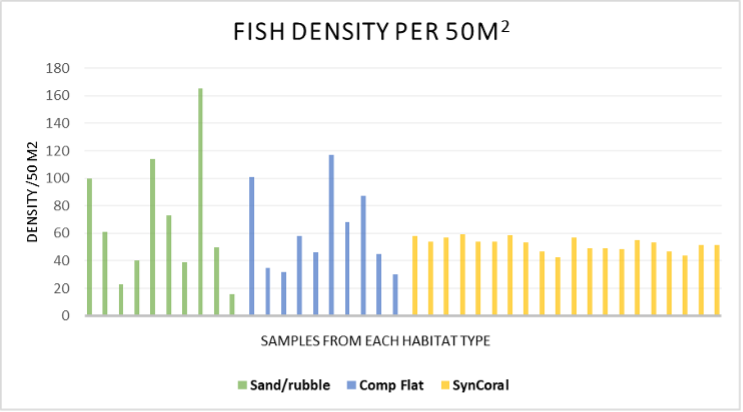
Rugosity has become an important measure of reef complexity (Luckhurst and Luckhurst, 1978; Carpenter et al.,1981; Turnigan, 1991; McCormick, 1994; Friedlander and Parrish, 1998); Gratwicke and Speight, 2005; Kuffner, et al., 2007; Shumway et al., 2007; Wilson et al., 2007; Purkis et al., 2008; Walker et al., 2009) and has been shown to be closely linked to fish abundance at both Wistari Reef and Hook Reef (Goeden G.B. and Ismail M.S., in press A). Although these research areas are on different reefs and geographically separated, we have used linear rugosity, Rulin, as a means of general comparison.
Figure 7 shows pooled fish density data for the two Wistari habitat types plotted against cell rugosity. Pooling results in much greater variance and R2 is consequently lower. We also plotted averaged artificial reef fish densities against their respective site rugosities. Note that the artificial reef sites contained a large expanse of sand with very low fish density while Wistari cells were “uniformly covered” through their full length with a well-established coral community. Based on the four artificial reef types, an Rulin >0.125 would tend to match or exceed the regression-derived natural reef fish density of Sand/Rubble and Compact Flat.
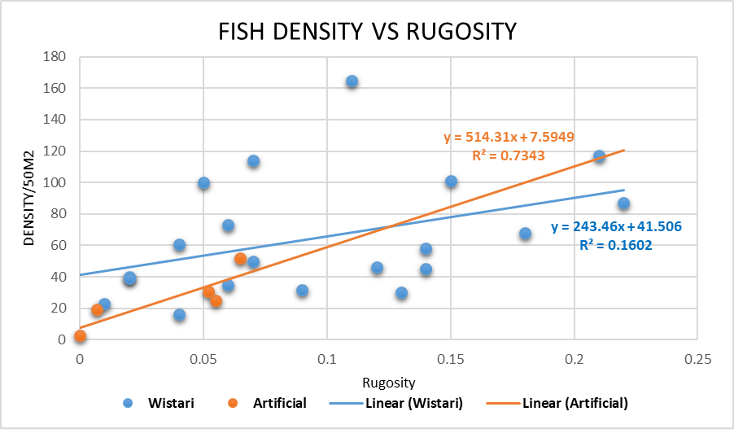
We repeated the comparisons using calculated biomass for SynCoral samples with those from Wistari natural habitat types. The mean fish biomass/50m2 for SynCoral was 15.04 kg/50m2. The most similar natural habitat types on Wistari Reef were Sand/Rubble with 19.73 kg/50m2 (g: 0.586950) and Compact Flat with 18.64 kg/50m2 (g: 0.597085). The next association was for Low Stag with a biomass of 18.99 kg/50m2 (g: 0.840718). Although not significantly different, the higher “g” for Low Stag is caused by an outlier producing a “large difference” with SynCoral. Other natural habitat types had significantly different biomass from SynCoral.
Regressing the biomass for the two pooled similar habitat types on Wistari Reef and the artificial reef sites against their respective rugosities produced very similar results to the fish density regressions in figure 7. This is not surprising and suggests that the fish lengths and weights for each species did not vary between habitats. The biomass of the artificial reefs was significantly correlated with rugosity (R2=0.7964) resulting in the lowest value for Reef Ball and the highest value for SynCoral.
Comparisons between the pooled data for North and South artificial reef locations showed no significant difference in biomass due to high variance. When separated, all artificial Reef Types differed significantly (p<.001) from the Sand Control. All pairwise comparisons of artificial reef samples were significantly different (Table 1) with the exception of Broken Rock and Layer Cake, p>.05. Therefore, fish biomass was, for the most part, significantly different (p <.05) with respect to different artificial Reef Types, i.e. Reef Type was an important predictor of fish biomass.
| Artificial Reef Type | Mean Biomass kg/50m2 |
| Sand Control | 0.283 |
| Reef Ball | 3.366 |
| Broken Rock | 6.838 |
| Layer Cake | 8.186 |
| SynCoral | 15.036 |
Table 1. Comparison of biomass in different artificial reef sites.
Although all artificial reef types showed significantly increased biomass compared to the Sand Control at Hook Reef, we found that simple piles of Broken Rock outperformed Reef Balls by about 100%. SynCoral produced the greatest increase in biomass with about 53 times more than the simple Sand Control and significantly more than all other artificial reef types.
Discussion
In all cases, we found that fish abundance was positively correlated with habitat complexity as has been established by numerous other studies (Luckhurst & Luckhurst, 1978; Carpenter et al., 1981; Turnigan, 1991; McCormick, 1994; Friedlander, A.M. & Parrish, J.D. (1998); Gratwicke & Speight, 2005; Kuffner et al., 2007; Shumway et al., 2007; Wilson et al., 2007; Purkis et al., 2008; Walker et al., 2009). The nature of this relationship will vary with a range of environmental factors, geography, species mix, etc. Our results will apply most closely to the central and southern Great Barrier Reef. Goeden & Ismail (in press B) found that the correlation for the linear regression of fish abundance on coral cover for their combined data was weak (R2=0.2533), but their linear regression of fish abundance within each cell with the rugosity in that cell was more highly correlated (R2=0.6636). These two relationships suggest that changes in rugosity are better predictors of fish abundance than changes in coral cover. These results contrast with Komyakova et al. (2013) who found “critical” relationships between coral richness and cover and fish populations.
If we use Rulin as a guide, then building artificial reefs with a value of Ru~0.125 in this geographic region will result in a fish density and biomass comparable to the two and similar to a third relatively low rugosity habitat types on Wistari Reef. Importantly, the rugosity of these natural habitats was generated by a coral framework while the rugosity of the artificial reef modules was generated with OPC concrete. These materials are chemically very different (OPC contains large amounts of SiO2 and Al2O3 and coral skeletons are principally CaCO3). While these differences effect the settlement success of many sedentary animals, it appears to be the rugosity of the substrate that has the greatest impact on fish abundance. This implies that SynCoral artificial reefs can serve as reasonably effective proxies for damaged Natural Reefs and their fish populations where we design them to match the pre-existing rugosity.
MacNeil, et al. (2015) stated that, “Coral reefs that maintained 500 kilograms of fish biomass per hectare [about 50 percent of an average reef's carrying capacity or about 2.5kg/50m2] were found to maintain ecological functions while sustaining local fisheries, providing fishers and marine managers with a critical target.” Table 1 above shows that Reef Ball did reach the MacNeil, et al. (2015) “sustainable biomass” level and maintained it over 18-month’s monitoring while all other Reef Types greatly exceeded that level. The rapid colonization of our artificial reefs by larger fishes points to greater attraction than production although SynCoral in particular recruited large numbers of very small fish. Observation suggested that it was the availability of small shelter spaces and shelters of different sizes that led to the higher performance of broken concrete and SynCoral. The attraction/production debate is often misunderstood. Attraction in itself, operates relative to the surroundings and the availability of alternative shelter. Where there is little shelter in the surroundings (e.g. our sandy Control areas), predation would be higher and survival and biomass would be greatly reduced; little production would take place. The converse of this is also true. Where there is greater production in the surroundings (e.g. a rocky substrate) and fish are attracted to added artificial reefs, fishermen may target the artificially high populations, overfishing can occur, and overall production may be reduced. It is this last possibility that leads to the assumption that “attraction is undesirable”. There are difficulties in separating attraction and production since Natural and artificial reefs can never be completely isolated if artificial reefs are to be colonized. Further research might explore the relationship between the size and timing of early colonizers and the distance from Natural Reef fish populations as well as the distances that larger reef fish travel over “open substrates” in search of food and shelter.
Building large scale artificial reef projects with even greater rugosity is likely to approximate the fish community density and biomass over a range of more heavily populated coral reef environments. Paxton et. al., (2020) through meta-analysis found that species richness was similar between natural and artificial reefs based on global results. It is our view that, with further design development, SynCoral artificial reef systems have the potential to maintain both fish biomass and species richness approaching that of heavily populated coral reef environments. This may be the best option in the face of growing coral reef loss due to global warming, eutrophication, and ocean acidification. We believe that artificial reefs can be designed to provide enough primary production to support a variety of trophic groups in the face of rapid environmental change. If this is correct, then the construction of well designed, very large scale artificial reef systems using SynCoral may help to offset the current loss of biomass and instead, maintain fisheries production and food security by increasing the functional size of coral reef habitats.
References
Affendi Y. A. (2014). Biorock Pulau Tioman. Universiti Kebangsaam Malaysia, Slide Share pp35
Albalawi, H. I., Khan, Z. N., Valle-Pérez, A. U., Kahin, K. M., Hountondji, M., Alwazani, H., … Hauser, C. A. E. (2021). Sustainable and Eco-Friendly Coral Restoration through 3D Printing and Fabrication. ACS Sustainable Chemistry & Engineering. doi:10.1021/acssuschemeng.1c04148
Arena P. T., Jordan L. K. B. and Spieler R. E. (2007). Fish assemblages on sunken vessels and natural reefs in southeast Florida, USA. Hydrobiologia 580, 157–171. doi: 10.1007/s10750-006-0456-x
Becker A., Taylor M. D., Folpp H. and Lowry M. B. (2018). Managing the development of artificial reef systems: the need for quantitative goals. Fish 19, 740–752. doi: 10.1111/faf.12288
Bohnsack J. A., Eklund A. M. and Szmant A. M. (1997) Artificial reef research: Is there more than the attraction production issue? Fish Aquac Isr Fig 22. (4):14-16
Bohnsack J. A., Harper D. E., McClellan D. B. and Hulsbeck M. (1994). Effects of reef size on colonization and assemblage structure of fishes at artificial reefs off southeastern Florida, U.S.A. Bull. Mar. Sci. 55, 796–823.
Bradbury R. H. and Goeden G. B. (1974). The partitioning of the reef slope environment by resident fishes. Proc. 2nd Int. Coral Reef Symp., 2: 167-178.
Burke L., Reytar K., Spaulding M. and Perry A. (2011). Reefs at Risk Revisited. Washington DC: World Resources Institute.
Carpenter K. E., Miclat R. I., Albaladejo V. D. and Corpuz V. T. (1981). The influence of substrate structure on the local abundance and diversity of Philippine reef fishes. Proc 4th Int Coral Reef Symp Manila 2:497–502.
Carr M. H. and Hixon, M. A. (1997). Artificial reefs: the importance of comparisons with natural reefs. Fish 22, 28–33. doi: 10.1577/1548- 8446(1997)0222.0.CO;2
Cohen J. (1977). Statistical power analysis for the behavioral sciences. Routledge.
Edwards A. J. and Gomez E. D. (2007). Reef Restoration Concepts and Guidelines: making sensible management choices in the face of uncertainty. Coral Reef Targeted Research & Capacity Building for Management Programme: St Lucia, Australia, iv + 38 pp
Friedlander A. and Parrish J. D. (1998). Habitat characteristics affecting fish assemblages on a Hawaiian coral reef. JEMBE 224: 1–30.
Froehlich C. Y. M. and Kline R. J. (2015). Using fish population metrics to compare the effects of artificial reef density. PLoS ONE 10:e0139444. doi: 10.1371/journal.pone.0139444
Goeden G. B. (1971). A survey of reef flat coral cover at Heron Island, Qld. National Parks Branch. Internal Report, 17pp.
Goeden G. B. and Ismail M. S. (in press A) Measuring the Effectiveness of Various Artificial Reef Design Parameters
Goeden G. B. and Ismail M. S. (in press B) Fish, Coral and Community Structure: 35 Years of Change on Wistari Reef, Australia
Granneman J. E. and Steele M. A. (2015). Between artificial and natural reefs. ICES J. Mar. Sci. 72, 2385–2397. doi: 10.1093/icesjms/fsv094
Gratwicke B. and Speight M. R. (2005). Effect of habitat complexity on Caribbean marine fish assemblages. Mar. Ecol. Prog. Ser., 292: 301-310. doi:10.3354/meps292301.
Hedges L. (1981). Distribution Theory for Glass’s Estimator of Effect Size and Related Estimators. Journal of Educational Statistics. Vol. 6, No. 2 (Summer, 1981), pp. 107-128.
Ilieva I., Jouvet L., Seidelin L., Best B. D., Aldabet S., Da Silva R., et al. (2019). A global database of intentionally deployed wrecks to serve as artificial reefs. Data Brief 23:103584. doi: 10.1016/j.dib.2018.12.023
Komyakova, V., Munday, P. L. and Jones, G. P. (2013). Relative importance of coral cover, habitat complexity and diversity in determining the structure of reef fish communities. PLoS One, 8(12), e83178. https://doi.org/10.1371/journal.pone.0083178.
Kuffner I., Brock J., Grober-Dunsmore R., Bonito V., Hickey T. and Wright C. (2007). Relationships between reef fish communities and remotely sensed rugosity measurements in Biscayne National Park, Florida, USA. Environ. Biol. Fish., 78: 71–82. doi:10.1007/s10641-006-9078-4.
Kulbicki M., Guillemot N. and Amand M. (2005). A general approach to length-weight relationships for New Caledonian lagoon fishes. Cybium 29(3): 235-252
Lemoine H. R., Paxton A. B., Anisfeld S. C., Rosemond R. C. and Peterson C. H. (2019). Selecting the optimal artificial reefs to achieve fish habitat enhancement goals. Biol. Conserv. 238:108200. doi: 10.1016/j.biocon.2019.108200
Lotze H. K., Lenihan H. S., Bourque B. J., Bradbury R. H., Cooke R. G., Kay M. C., et al. (2006). Depletion, degradation, and recovery potential of estuaries and coastal seas. Science 312, 1806–1809. doi: 10.1126/science.1128035
Luckhurst B.E. and Luckhurst K. (1978). Analysis of the influence of substrate variables on coral reef fish communities. Mar. Biol. 49: 317–323
MacNeil M. A., Graham N. A. J., Cinner J. E., Wilson S. K., Williams I. D., Maina J., Newman S., Friedlander A. M., Jupiter S., Polunin N. V. C. and McClanahan T. R. (2015). Recovery potential of the world’s coral reef fishes. Research Letters 2 Nature vol. 000 | 00 month
Macreadie P. I., Fowler A. M. and Booth D. J. (2011). Rigs-to-reefs: will the deep sea benefit from artificial habitat? Front Ecol Environ 9(8): 455–461, doi:10.1890/100112
Madin E. M. P., Madin J. S. and Booth D. S. (2011). Landscape of fear visible from space. 1: 14 DOI: 10.1038/srep00014
McClenachan L., O’connor G., Neal B. P., Pandolfi J. M. and Jackson, J. B. C. (2017). Ghost reefs: nautical charts document large spatial scale of coral reef loss over 240 years. Sci. Adv. 3:e1603155. doi: 10.1126/sciadv.1603155
McCormick M. I. (1994). Comparison of field method for measuring surface topography and their associations with a tropical reef fish assemblage. Mar. Ecol. Prog. Ser., 112(1/2): 87–96. doi:10.3354/meps112087.
McGurrin J. M., Stone R. B. and Sousa R. J. (1989). Profiling United States artificial reef development. Bull. Mar. Sci. 44, 1004–1013
Mercader M., Mercière A., Saragoni G., Cheminée A., Crec’hriou R., Pastor J., et al. (2017). Small artificial habitats to enhance the nursery function for juvenile fish in a large commercial port of the Mediterranean. Ecol. Eng. 105, 78–86. doi: 10.1016/j.ecoleng.2017.03.022
Millennium Ecosystem Assessment (2005). Ecosystems and Human Well-Being. Washington DC: Island Press
National Oceanic and Atmospheric Administration (2007). National Artificial Reef Plan (as Amended): Guidelines for Siting, Construction, Development, and Assessment of Artificial Reefs. National Oceanic and Atmospheric Administration (NOAA).
Paxton A. B., Peterson C. H., Taylor J. C., Adler A. M., Pickering E. A. and Silliman B. R. (2019). Artificial reefs facilitate tropical fish at their range edge. Commun. Biol. 2:168. doi: 10.1038/s42003-019-0398-2
Paxton A. B., Pickering E. A., Adler A. M., Taylor J. C. and Peterson C. H. (2017). Flat and complex temperate reefs provide similar support for fish: Evidence for a unimodal species-habitat relationship. PLoS ONE 12:e0183906.
doi: 10.1371/journal.pone.0183906
Paxton A. B., Shertzer K. W., Bacheler N. M., Kellison G. T., Riley K. L. and Taylor J. C. (2020). Meta-Analysis Reveals Artificial Reefs Can Be Effective Tools for Fish Community Enhancement but Are Not One-Size-Fits-All. Front. Mar. Sci. 7:282. doi: 10.3389/fmars.2020.00282
Purkis S. J., Graham A. J. and Riegel B. E. (2008). Predictability of reef fish diversity and abundance using remote sensing data in Diego Garcia (Chagos Archipelago). Coral Reefs 27: 167–178.
Risk M. J. (1972). Fish diversity on a coral reef in the Virgin Islands. Atoll. Res. Bull., 153: 1-6. doi:10.5479/si.00775630.153.1.
Seaman W. (2002). Unifying trends and opportunities in global artificial reef research, including evaluation. ICES J. Mar. Sci. 59, S14–S16. doi: 10.1006/jmsc.2002.1277
Seaman W. (2007). Artificial habitats and the restoration of degraded marine ecosystems and fisheries. Hydrobiologia 580, 143–155. doi: 10.1007/s10750-006-0457-9
Shumway C., Hofmann H. A. and Dobberfuhl A. (2007). Quantifying habitat complexity in aquatic ecosystems. Freshwater Biol. 52: 1065–1076.
Simon T., Joyeux J. C. and Pinheiro H. T. (2013). Fish assemblages on shipwrecks and natural rocky reefs strongly differ in trophic structure. Mar. Environ. Res. 90, 55–65. doi: 10.1016/j.marenvres.2013.05.012
Stone R. B., McGurrin J. M., Sprague L. M. and Seaman W. J. (1991). “Artificial habitats of the world: synopsis and major trends,” in Artificial Habitats for Marine and Freshwater Fisheries, eds W. J. Seaman and L. M. Sprague (San Diego, CA: Academic Press), 31–60
Stone R. B., Pratt H. L., Parker Jr R. O. and Davis G. E. (1979). A comparison of fish populations on an artificial and natural reef in the Florida Keys. Mar. Fish. Rev. 41, 1–11.
Turnigan R. G. (1991). The influence of habitat complexity on diversity, abundance, and distribution of fish on a coral reef. Proc. 44th Gulf and Caribbean Fisheries Inst. pp 759–766
United Nations Environment Programme (2009). London Convention and Protocol/UNEP Guidelines for the Placement of Artificial Reefs. London: United Nations Environment Programme (UNEP).
Walker B. K., Jordan L. K. B. and Spieler R. E. (2009). Relationship of reef assemblages and topographic complexity on southeastern Florida coral reef habitats. J. Coast Res. 53: 39–48
Williams I. D. and Polunin N. V. C., (2001). Large-scale associations between macroalgal cover and grazer biomass on mid-depth reefs in the Caribbean. Coral Reefs 19:358-366.
Wilson S. K., Polunin N. V. C. and Graham N.A.J. (2007). Appraisal of visual assessments of habitat complexity and benthic composition on coral reefs. Mar. Biol. 151: 1069–1076
Would you like to know more about our initiatives? Feel free to contact us
Address Leonard Springerlaan 35 9727KB Groningen
The Netherlands
info@fizzytransition.com
© 2021 Fizzy Transition Ventures B.V.